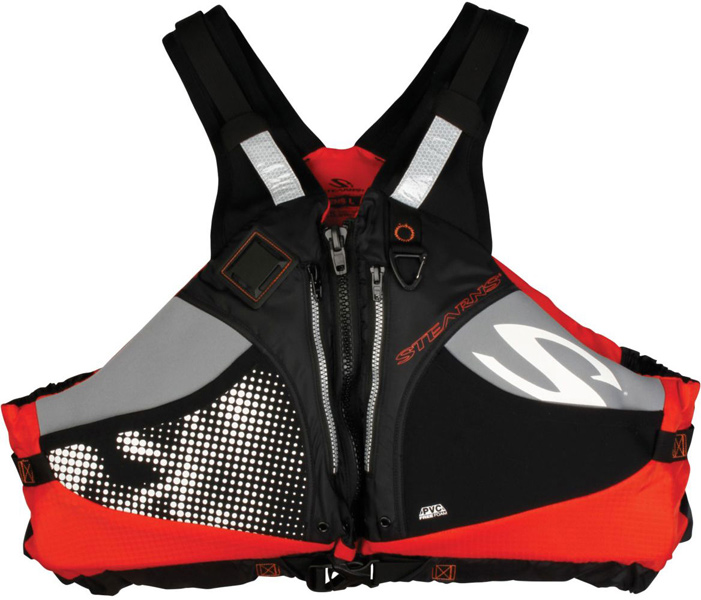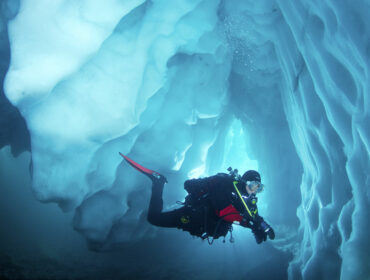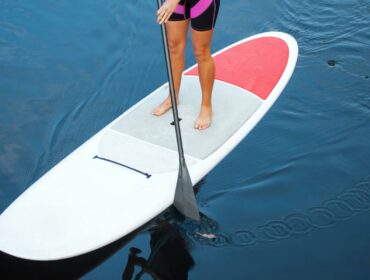Stand-up paddle boarding (SUP) is a fun and relaxing sport that can be enjoyed in all sorts of climates and in pretty much all bodies of water—oceans, rivers, lakes, you name it. Because of this, proper paddle boarding attire is a broad spectrum, ranging from bikinis and board shorts to full-length wetsuits or drysuits. However, this flexibility leaves more room for error and can confuse new paddlers who have no idea what to wear on a SUP board for the first time.
In this article, we’ve created a comprehensive list of gear and clothing items that you can wear to complete your paddleboard outfit and ensure a comfortable, safe, and fun SUP experience.
What Should You Wear for Stand Up Paddle Boarding?
The following items are recommended for SUP boarding in warm and cold conditions. We’ve also included a few product recommendations for each so you can easily choose high-quality products.
Personal Floatation Device

A personal flotation device is one item you should never forget to wear when paddle boarding. Many don’t wear them when paddle boarding in calm and shallow waters. Still, since SUPs are recognized as vessels, the law requires them to carry a personal flotation device and a whistle, especially when traveling outside swim and surf zones.
Any life jacket will do, but those made especially for stand-up paddle boarding usually have wide armholes to allow a full range of motion and are approved by the U.S. Coast Guard.
Swimsuit / Swimming Trunks
When paddle boarding on lovely, warm days, you can wear your favorite swimsuit or trunks. The key here is comfort—as long as you’re comfortable wearing it and it doesn’t easily slip off when you hit the water, you can get on your board and be done with it.
A good swimsuit will also allow you to go for a quick swim without changing your outfit.
Recommended Products:
Board Shorts

Many paddlers, especially men, prefer to wear long shorts. In this case, they can choose to wear board shorts. Any kind will do, so you may not have to replace the one you’ve been using for strolls on the beach. As long as they’re comfortable and quick drying, they’re perfectly suitable for stand-up paddle boarding.
For added benefits, make sure it’s made of sun-protective fabric, which can help prevent sunburn.
Recommended Products
Rash Guards

Another type of paddle-boarding attire that you may want to wear is a one—or two-piece rash guard. Aside from protecting you from chafing, rashes, and skin irritations that can be caused by frequent stand-up paddle-boarding, it’s the perfect undergarment for layering with hoodies, wetsuits, and/or drysuits when swimming and surfing in cold and windy surf zones.
Rash guards are suitable for a wide range of water activities. Just make sure to choose a snug-fitting one with UV protection, flat-lock stitching to prevent skin chafing, and the right amount of coverage (sleeve length) for your desired level of insulation.
Recommended Products:
Wetsuit

Wetsuits are popular among divers but are also perfectly suitable for engaging in water sports during winter or in cold climate areas.
In colder waters, a wetsuit can be layered on top of a rash guard or swimsuit (check out this article on what to wear under wetsuits for more information) for added warmth, but it can also be worn on its own. This is because a good-fitting wetsuit can keep you sufficiently warm by itself. It works by trapping a thin layer of water between the skin and the fabric and allowing your body to naturally heat up that layer of water to keep cold water from reaching your skin.
Wetsuits vary in thickness and coverage, depending on your desired level of warmth. When paddle boarding in winter, you’ll want a full-body wetsuit that’s at least 3mm thick, but probably not over 6mm so as not to restrict your movement significantly. Should you wish to have a thinner, more flexible suit that provides extra warmth, you might prefer a drysuit instead.
Recommended Products:
- Lavacore Women’s Full Suit ($164.95)
Drysuit

Unlike wetsuits, drysuits don’t trap a layer of water to insulate the body. Instead, they use their specialized, waterproof material to trap air that naturally gets warmed with body heat. Drysuits provide maximum warmth, but they’re not the most comfortable option and are usually expensive.
However, drysuits also suit a wide range of water activities, including kayaking and deep-water diving in cold conditions. Even when layered with undergarments, they allow more movement than winter wetsuits.
Recommended Products:
Jackets

Stand-up paddle boarding jackets are a great option if you want a thermal top for layering. They’re usually very lightweight, breathable, and easy to wear, sometimes even with a stashable hood in case you want extra protection for the head. Their specialized mix of fabrics, stern seals, and gaskets for all openings, and fully taped seams keep most of the water out and keep you dry longer. Another unique feature of most SUP jackets is their splash-proof sleeve pocket for keeping valuables close.
Headgear

You can protect your head and hair or add warmth by wearing a hat or cap. Some usually wear a regular baseball cap or beach hat when paddle boarding in warm waters, but these options are not necessarily designed to stay on and are not waterproof. A beach hat can quickly fly off your head with a powerful gust of wind, and you’ll have to paddle around to get it back.
Instead, go for neoprene wet caps that dry quickly and have headbands or adjustable straps that help ensure a secure fit throughout. Depending on your desired comfort level, protection, and insulation, you can also get a river rafting helmet or a watertight, full-face hood.
Recommended Products:
Gloves

You may also need to wear hand gloves to protect your hands from cuts and scrapes and to help keep them warm. Those specifically made for paddle boarding are designed with a good grip for your paddles, an anatomical fit for decreased hand fatigue, comfortable inner materials, and thin rubber fabric, so they feel like your “second skin.”
Like every other piece of attire on this list, it’s important to choose gloves that fit snugly on your hands and won’t bunch up uncomfortably when in use.
Recommended Products:
Surf Booties / Aqua Socks
Although paddlers often prefer to go barefoot to feel the board better and be more connected to its movements, some wear watersport shoes, surf booties, or aqua socks for increased grip and protection. Such footwear can be beneficial when stepping on the ground, where there may be rocks, oyster shells, and other sharp objects. At the same time, they provide warmth and insulation when paddle boarding in cool temperatures.
It’s important to note that land shoes are not ideal for water use as they will weigh your feet down when wet and are not designed for slippery surfaces. Choose water footwear that drains quickly, is comfortable and well ventilated, and has a flexible sole that allows you to keep your balance. Water sandals and flip-flops are also workable, but their loose fit only makes them suitable for calm waters.
Recommended Products:
Leash
Finally, before you go out on your board, another thing you should remember to have is a leash. Like the personal floatation device, the leash is mainly for your convenience and safety—so you don’t have to chase your board when you fall off it, plus it helps you keep it close when you get lost or find yourself too far from the shore.
Leashes usually offer multiple attachment points, so you can connect your calf or ankle to the tail of your paddleboard—or use them to connect your paddle to your wrist. We recommend coiled leashes, so they don’t drag behind you or get tangled.
Recommended Products:
| Warm Conditions | Cold Conditions | |
| Personal Floatation Device |  | |
| Leash |  | |
| Water Cap / Bonnet / Hoodie |  |  |
| Water Shoes / Surf Booties / Aqua Socks |   | |
| Rash Guard |  |  |
| Swimsuits / Swimming Trunks / Water Shorts |   | |
| Board Shorts |  | |
| Wetsuit |  | |
| Drysuit |  | |
| Water Jackets |  | |
| Gloves |  |
Choosing Your Paddle Board Outfit
As with any water sport, there’s no strict rule on what to wear for stand-up paddle boarding. Technically, you can wear whatever you want, especially in calmer waters during summertime. It depends on how warm you want to be, how much of your body you want to keep protected, the water flow (is it calm or turbulent?) on that specific day, and the type of water activity you will be participating in. But with this guide, we hope you now know how to customize your paddleboarding outfit according to your needs.




